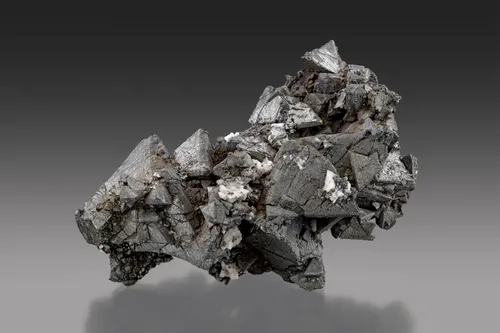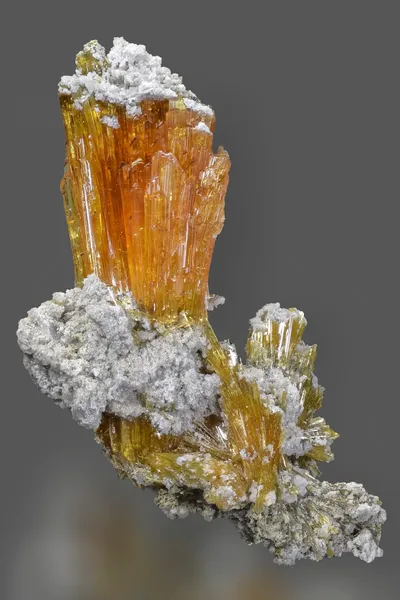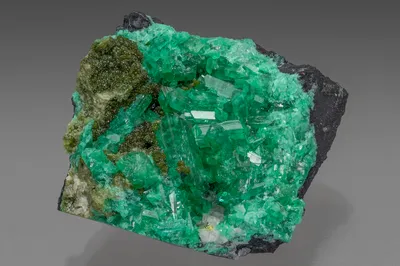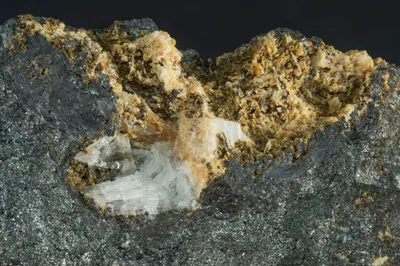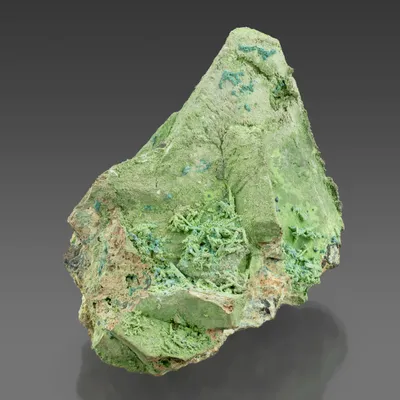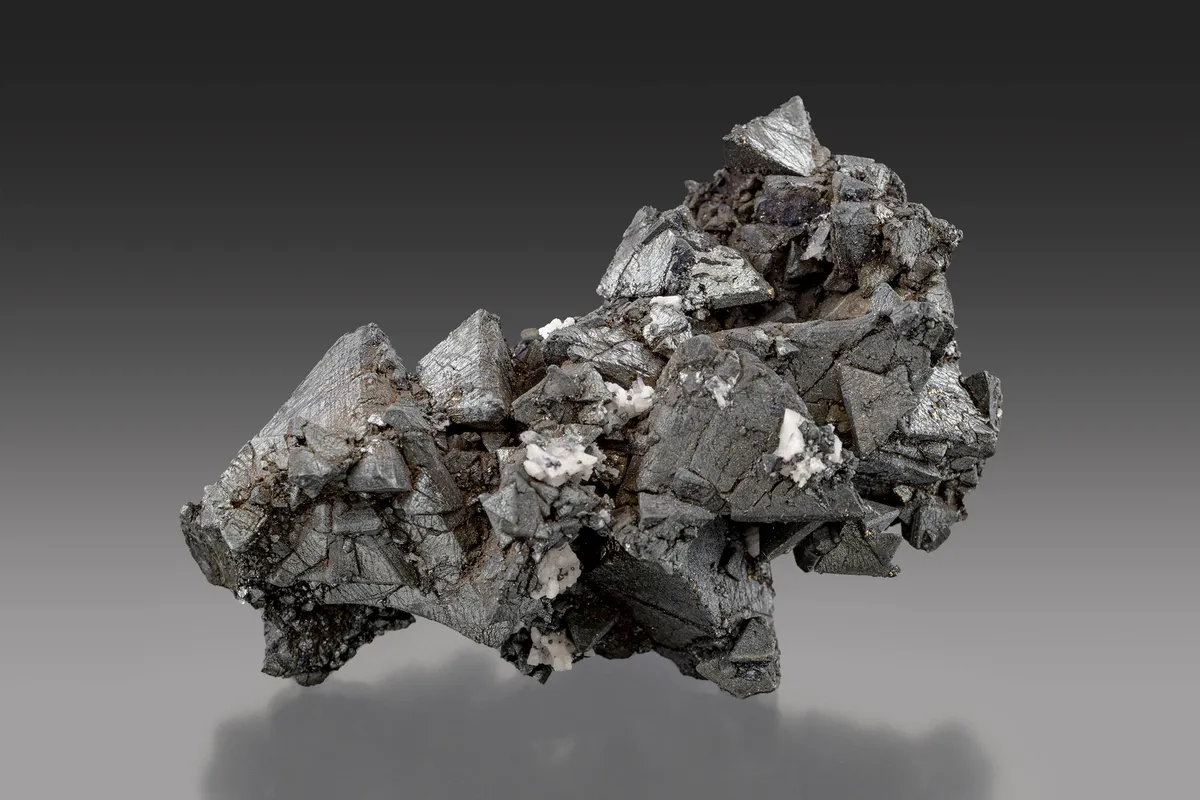
Image Credit: Malcolm Southwood
Mineral Species
Tennantite-(Zn)
Type Locality
No
Composition
Cu6(Cu4Zn2)As4S13
Crystal System
Cubic
Status at Tsumeb
Confirmed
Abundance
Very common
Distribution
First, second and third oxidation zones; sulphide ores
Paragenesis
Hypogene; supergene (?)
Entry Number
Species; TSNB347
General Notes
The reclassification and revised nomenclature rules for minerals of the tetrahedrite group (Biagioni et al. 2020a) have led to the approval of several newly defined species as members of a tennantite subgroup; these new minerals would previously have fallen under the single species name "tennantite". A general formula for the tennantite series can be written as Cu6(Cu4M2)As4S13 with each species defined by M, which can be Cd, Cu, Fe, Hg, Mn, Ni or Zn.
Further work is needed to be confident which of the newly defined species are present at Tsumeb and in what proportions but it appears that the hypogene tennantite is predominantly tennantite-(Zn), while quantitative WDS analysis has indicated the relatively rare occurrence of tennantite-(Cu) as a pseudomorphous replacement after enargite (M. Števko and M. Southwood; unpublished data).
Throughout these notes, the term "tennantite" (i.e. italicised and without a chemical element suffix) refers to what is believed to be tennantite-(Zn).
Tennantite is an abundant component of the hypogene (sulphide) assemblage at Tsumeb. From an economic perspective, tennantite was the most important primary copper ore at depth and an important source of zinc, silver and arsenic. It occurs typically as fine anhedral grains in massive sulphide ores, but also as larger solid masses and occasionally as attractive well-formed crystals (Keller 1977a). Tennantite is a common matrix mineral for many secondary species; indeed geochemically, oxidising tennantite is the major source of arsenate ions and some of the base metal ions that come together to form secondary arsenates.
The vast majority of the Tsumeb-related literature (pre-2020) refers simply to "tennantite" which, before 2019 was an IMA-approved (grandfathered) species name.
Pufahl (1920) provided the first published analysis of "zinkreiches arsen-fahlerz" (= zinc-rich tennantite) from Tsumeb. He analysed two samples, one from a galena-rich ore specimen and one from a sample of drill core from between 4 Level and 5 Level in which the tennantite was associated with chalcocite. Both analyses were remarkably similar. The major elements for the drill core specimen were reported as Cu 43.6 wt %; Zn 9.27 %; S 23.25 %; As 17.9 %; Sb 4.66 %. This composition is consistent with tennantite-(Zn) as defined by Biagioni et al. (2020). Pufahl (1920) also noted the importance of tennantite as a source of gold and silver; his analysis of the drill core tennantite returned assays of 1.11 kg/tonne silver, and 125 g/tonne gold.
Ore microscopy studies by Moritz (1933) eliminated the possibility that the high zinc content of tennantite determined by Pufahl (1920) was due to inclusions of sphalerite. Moritz (1933) also demonstrated that the so-called "green enargite" (of Schneiderhöhn 1920) is tennantite, formed as a reaction product from enargite. Hughes (1987) pointed out that this tennantite, composition unknown, may not be of hypogene origin.
Klein (1938) recognised the importance of tennantite as a primary ore of copper and as the source of the arsenic present in many secondary minerals at Tsumeb. He noted significantly higher tennantite concentrations between 130-170 m depth (5, 6 and 7 levels), 360-410m (13, 14 and 15 levels) and again at 520 m (18 Level). Klein also recorded the discovery of "gigantic" tennantite crystals on 6 Level and his contemporary photograph of one of these crystals from the Kegel Collection was reproduced by Gebhard (1999, page 110). The dominant crystal on this specimen measures 185 mm on edge and it has been described (and figured) by Pohwat (2011). This specimen is now in the collection of the Smithsonian Institution (catalogue number NMNH R8534).
Geier (1962) stated that the average zinc content of tennantite grains picked from the copper concentrate at Tsumeb was approximately 8 wt % and Geier (1973-1974) later added that studies of the ore between levels 20 and 26 had shown a zinc content in tennantite in the range 7-9 wt %. Once again, these analyses are consistent with tennantite-(Zn).
Pinch and Wilson (1977) noted that "Tennantite forms superb tetrahedral crystals up to 30 cm on an edge, and large masses of steel-gray metallic ore. … Crystals of tennantite are occasionally lustrous but are more often frosty or corroded".
Keller (1977a) wrote that:
"During the last few years, complete tennantite crystals of tetrahedral form have been recovered. The crystal faces were rough and etched. It is not yet possible to determine whether these crystals formed in open cavities or were freed through the disintegration of surrounding ore material. The latter is most likely".
Keller (1984) noted that well-formed tennantite crystals generally comprise the following forms: {111}, {100} and {211}. The crystals invariably have an etched appearance which he believed to be consistent with his hypothesis that the crystals were released as the enclosing sulphide minerals oxidised.
Lombaard et al. (1986) considered tennantite a "very common" mineral at Tsumeb and showed that it becomes increasingly abundant with depth, accounting for less than 20 vol. % of the ore in the first oxidation zone rising to c. 45 vol. % below the second oxidation zone. They recorded that Tsumeb tennantite contains up to 9 % Zn, up to 0.85 % Fe, and up to 0.487 % Sb. The silver content of tennantite increases with depth, ranging from 160-600 ppm between surface and 24 Level, but rising to 1800 ppm on 38 Level. Germanium is also enriched in tennantite in the range 60-700 ppm.
Lombaard et al. (1986) proposed the following paragenesis for the hypogene assemblage at Tsumeb, with two generations of tennantite forming mid- and late-sequence:
[calcite(i) + albite] >> pyrite(i) >> [quartz(i) + dolomite(i)] >> chalcopyrite(i) >> [germanite(i) + sphalerite(?)] + briartite(?)] >> renierite(i) >> germanite(ii – by reaction) >> [molybdenite + tungstenite] >> sphalerite(green) >> gallite >> sphalerite(brown) >> enargite(?) >> [tennantite(i) + bornite] >> [chalcopyrite(ii) + linnaeite] >> galena(i) >> pyrite(ii) >> germanite(iii ?) >> renierite(ii ?) >> galena(ii ?) >> tennantite(ii) >> pyrite(iii) >> quartz(ii) >> [baryte + fluorite] >> dolomite(ii) >> calcite(ii)
Hughes (1987) recorded three "varieties" of tennantite at Tsumeb:
Gebhard (1999) recorded that crystals of tennantite (to 30 mm) with a good metallic lustre were recovered from 45 Level in the third oxidation zone. The tennantite crystals were associated only with quartz and occurred in a "dyke" that, according to Gebhard had probably been filled with calcite which was later leached away.
Tennantite is specifically mentioned as a component of the type assemblage in the original description of the following minerals: andyrobertsite (Cooper et al. 1999); arsendescloizite (Keller and Dunn 1982a); bartelkeite (Keller et al. 1981a); calcioandyrobertsite (Cooper et al. 1999); brunogeierite (Ottemann and Nuber 1972); calvertite (Jambor et al. 2007); eyselite (Roberts et al. 2004); fahleite (Medenbach et al. 1988); ferrilotharmeyerite (Ansell et al. 1992); fleischerite (Frondel and Strunz 1960); gallite (Strunz et al. 1958b); gallobeudantite (Jambor et al. 1996); helmutwinklerite (Süsse and Schnorrer 1980); itoite (Frondel and Strunz 1960); johillerite (Keller et al. 1982a); keyite (Embrey et al. 1977b); koritnigite (Keller et al. 1979d); krieselite (Schlüter et al. 2010); leiteite (Cesbron et al. 1977); ludlockite (Embrey et al. 1977c); o’danielite (Keller et al. 1981d); otjisumeite (Keller et al. 1981c); queitite (Keller et al. 1979a); schneiderhöhnite (Ottemann et al. 1973); stibioclaudetite (Origlieri et al. 2009); stottite (Strunz et al. 1958a); tsumgallite (Schlüter et al. 2003); warikahnite (Keller et al. 1979b) and zincroselite (Keller et al. 1986).
Paar (1973) described langite forming aggregates in cracks and depressions on the surface of enargite "drillings" (twins) recovered during an investigation of minerals from levels 34 and 35 (towards the bottom of the second oxidation zone). Bartelke (1976) clarified that these enargite crystals are in fact pseudomorphs of tennantite after enargite. These pseudomorphs (and others like them) have been variously interpreted as tennantite after enargite (Bartelke 1976), tennantite after azurite (Weber 1977; Gebhard 1999) and tennantite after chalcocite. Ore microscopy confirms that some of these, at least, are tennantite replacing enargite. It is possible that such replacements are of supergene origin. Please also refer to the notes on tennantite-(Cu).
Associated Minerals
adamite; andyrobertsite; anglesite; argutite; argyrodite (?); arsendescloizite; arsentsumebite; arthurite (?); austinite; azurite; bartelkeite; baryte; bayldonite; beaverite-(Cu); bendadaite; berthierine; betekhtinite; bornite; briartite; brochantite; brunogeierite; calcioandyrobertsite; calvertite; cerussite; chalcocite; chalcopyrite; clausthalite; conichalcite; cupropearceite; cupropolybasite; devilline; dolomite; duftite; enargite; erikapohlite; euchroite (?); eyselite; ferrilotharmeyerite; fahleite; fleischerite; freedite (?); galena; gallite; gallobeudantite; germanite; germanocolusite; gypsum; helmutwinklerite; hörnesite; jamesonite (?); jarosite (?); johillerite; karibibite; kësterite; keyite; koritnigite; köttigite; krieselite; lammerite; langite; larsenite; lavendulan; leiteite; lepidocrocite (?); linarite; ludlockite; malachite; mawsonite; mimetite; molybdenite; mottramite; o’danielite; ojuelaite; olivenite; otjisumeite; ovamboite; parnauite (?); posnjakite; powellite; pyrite; quartz; queitite; renierite; rutile; schaurteite; schneiderhöhnite; schultenite; scorodite; serpierite; skorpionite (?); smithsonite; söhngeite; sphalerite; spertiniite; stannite; stibioclaudetite; stolzite; stottite; stranskiite; stromeyerite; tsumcorite; tsumgallite; velikite (?); warikahnite; wroewolfeite (?); wulfenite; wurtzite; yvonite (?); zincolivenite; zincroselite
Pseudomorphs
Tennantite-(Zn) is reported to form pseudomorphs after the following minerals: azurite (common); chalcocite (common); enargite (common).
The following minerals are reported to form pseudomorphs after tennantite-(Zn): arsentsumebite (rare); austinite (rare); azurite (rare); bayldonite (rare); chalcocite (rare); dolomite (common); duftite (rare); enargite (rare); ferrilotharmeyerite (rare); jarosite (rare); malachite (rare); mottramite (rare); serpierite (rare).
